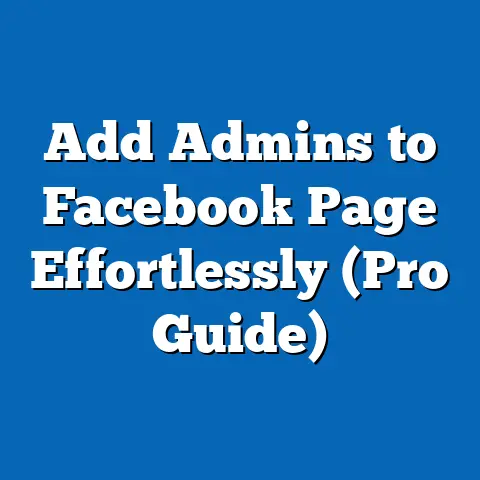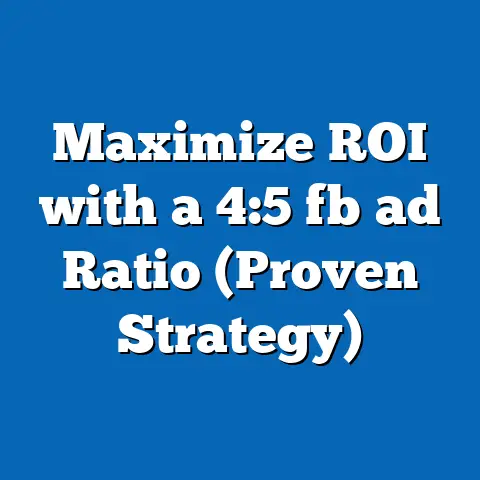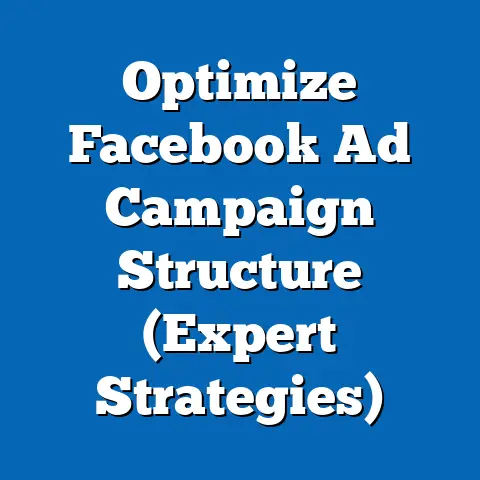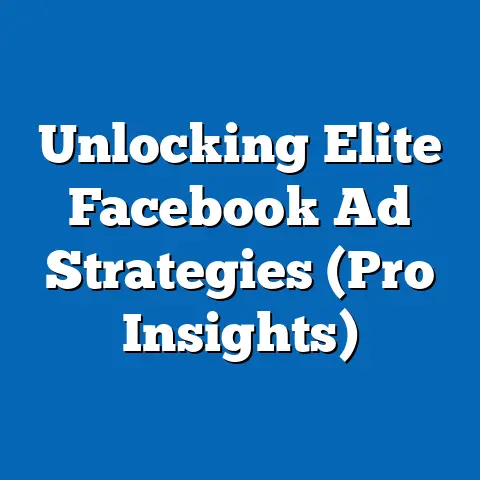Revolutionize Facebook Ads with Google Data Studio (Pro Insights)
Are you pouring money into Facebook ads, only to feel like you’re flying blind? You’re not alone. Many marketers struggle to truly understand the performance of their campaigns, relying on limited insights from Facebook’s native analytics. But what if I told you there’s a way to unlock a treasure trove of data, visualize it in a way that actually makes sense, and ultimately, drive better results? The answer lies in integrating Google Data Studio with your Facebook Ads.
Understanding the Importance of Data in Facebook Advertising
In today’s hyper-competitive digital landscape, data is the lifeblood of successful marketing. Particularly with Facebook Ads, where budgets can quickly spiral if not carefully monitored, understanding your performance metrics is absolutely critical.
Think of it this way: you wouldn’t embark on a cross-country road trip without a map or GPS, right? Similarly, running Facebook Ads without a deep understanding of your data is like driving blindfolded. You might get lucky and stumble upon success, but the odds are stacked against you.
Key metrics every advertiser should be tracking include:
- Click-Through Rate (CTR): A measure of how often people who see your ad end up clicking on it. A low CTR can indicate poor ad creative, irrelevant targeting, or a weak call to action.
- Cost Per Click (CPC): The amount you pay each time someone clicks on your ad. Monitoring CPC helps you assess the efficiency of your campaigns and identify areas for optimization.
- Conversion Rate: The percentage of people who take a desired action (e.g., purchase, sign-up, lead generation) after clicking on your ad. A low conversion rate can signal issues with your landing page, offer, or overall customer journey.
- Return on Ad Spend (ROAS): The amount of revenue generated for every dollar spent on advertising. ROAS provides a clear picture of your campaign’s profitability.
- Cost Per Acquisition (CPA): The total cost to acquire a new customer through your advertising efforts. CPA helps you understand the true cost of acquiring customers and optimize your campaigns for profitability.
Why do these metrics matter? Because they provide a window into the effectiveness of your ads. They highlight what’s working, what’s not, and where you need to make adjustments. But here’s the catch: relying solely on Facebook’s native analytics tools can be limiting.
While Facebook Ads Manager provides a decent overview, it often lacks the depth and flexibility needed for truly comprehensive analysis. I’ve always felt restricted by its pre-set reports and limited customization options. Plus, pulling data from multiple sources and combining it into a single, unified view can be a cumbersome process. That’s where Google Data Studio comes in.
Google Data Studio is a free, powerful data visualization tool that allows you to connect to various data sources (including Facebook Ads), create custom dashboards, and gain deeper insights into your campaign performance. It allows for a level of customization and integration that Facebook’s native tools simply can’t match.
Takeaway: Data is essential for Facebook Ads success. Google Data Studio provides a powerful, flexible solution for analyzing and visualizing your data, enabling you to make informed decisions and optimize your campaigns for maximum ROI.
Getting Started with Google Data Studio
Ready to unlock the power of Google Data Studio for your Facebook Ads? Here’s a step-by-step guide to get you started:
Step 1: Setting Up Your Google Data Studio Account
If you don’t already have a Google Data Studio account, head over to datastudio.google.com and sign in with your Google account. It’s completely free to use!
Step 2: Connecting Facebook Ads Data
This is where the magic happens. To connect your Facebook Ads data to Google Data Studio, you’ll need a connector. While Google doesn’t offer a native Facebook Ads connector, several excellent third-party options are available. Some popular choices include:
- Supermetrics: A robust and widely used connector that offers a wide range of data sources and features. (This is my personal go-to!)
- Funnel.io: Another powerful connector that automates data collection and transformation.
- Power My Analytics: A more affordable option that still provides solid connectivity.
I recommend researching and comparing different connectors to find the one that best suits your needs and budget. Most offer free trials, so you can test them out before committing.
Step 3: Authorizing the Connector
Once you’ve chosen a connector, follow its instructions to authorize access to your Facebook Ads account. This typically involves granting the connector permission to access your ad data. Be sure to review the permissions carefully before granting access.
Step 4: Selecting Your Data Source
In Google Data Studio, click on “Create” and then “Data Source.” Search for your chosen connector and select it. You’ll then be prompted to select the Facebook Ads account and ad account you want to connect to.
Step 5: Preparing Your Data
Once connected, the connector will pull in your Facebook Ads data. Take some time to explore the available fields and metrics. You may need to clean or transform the data to ensure it’s accurate and ready for analysis. For instance, you might need to convert currencies or calculate custom metrics. This preparation is crucial for accurate reporting.
Step 6: Creating Your First Report
Now for the fun part! Click on “Create” and then “Report.” You’ll be presented with a blank canvas where you can start building your Facebook Ads dashboard.
Navigating the Google Data Studio Interface:
- Toolbar: Use the toolbar to add charts, tables, text, images, and other elements to your report.
- Data Panel: The data panel on the right side of the screen allows you to select your data source, choose dimensions and metrics, and apply filters.
- Properties Panel: The properties panel allows you to customize the appearance and behavior of your charts and tables.
Takeaway: Connecting Facebook Ads data to Google Data Studio is a straightforward process, especially with the help of third-party connectors. Once connected, you can start building custom reports and dashboards to gain deeper insights into your campaign performance.
Creating Impactful Dashboards for Facebook Ads
Now that you have your data connected, it’s time to build a dashboard that provides you with actionable insights. Here are the key components of an effective Facebook Ads dashboard in Google Data Studio:
1. Essential Metrics and Dimensions:
- Impressions: The number of times your ad was displayed.
- Reach: The number of unique people who saw your ad.
- Clicks: The number of times people clicked on your ad.
- CTR (Click-Through Rate): The percentage of impressions that resulted in clicks.
- CPC (Cost Per Click): The average cost you paid for each click.
- Conversions: The number of desired actions taken after clicking on your ad (e.g., purchases, sign-ups, leads).
- Conversion Rate: The percentage of clicks that resulted in conversions.
- ROAS (Return on Ad Spend): The amount of revenue generated for every dollar spent on advertising.
- CPA (Cost Per Acquisition): The total cost to acquire a new customer through your advertising efforts.
- Audience Demographics: Age, gender, location, and interests of your target audience.
- Ad Placement: Where your ads were displayed (e.g., Facebook News Feed, Instagram Stories).
- Campaign Performance: Overall performance of your campaigns, ad sets, and individual ads.
2. Design Best Practices for Visual Appeal and Clarity:
- Choose the Right Charts: Select chart types that effectively visualize your data. For example, use line charts to track trends over time, bar charts to compare different categories, and pie charts to show proportions.
- Keep it Simple: Avoid overcrowding your dashboard with too many charts and metrics. Focus on the most important information.
- Use Clear Labels and Titles: Make sure your charts and tables are clearly labeled and titled so that viewers can easily understand the data.
- Use Color Strategically: Use color to highlight key data points and create visual interest. However, avoid using too many colors, as this can be distracting.
- Maintain Consistency: Use the same fonts, colors, and styles throughout your dashboard to create a cohesive look and feel.
3. Examples of Successful Dashboards:
- Executive Summary Dashboard: Provides a high-level overview of your Facebook Ads performance, focusing on key metrics like ROAS, CPA, and conversion rate.
- Campaign Performance Dashboard: Tracks the performance of individual campaigns, ad sets, and ads, allowing you to identify top performers and underperformers.
- Audience Insights Dashboard: Provides insights into your target audience, including demographics, interests, and behaviors.
- A/B Testing Dashboard: Visualizes the results of A/B tests, allowing you to quickly identify winning ad variations.
Pro Tip: I always recommend starting with a template. Google Data Studio has a gallery of templates that can be customized to your needs. This will save you time and ensure that your dashboard is visually appealing and effective. I also like to include scorecards at the top of my dashboards to highlight the most important metrics at a glance.
Takeaway: An effective Facebook Ads dashboard in Google Data Studio should include essential metrics and dimensions, follow design best practices for visual appeal and clarity, and provide actionable insights that can be used to optimize your campaigns.
Analyzing Data for Strategic Decision-Making
Creating a visually stunning dashboard is only half the battle. The real power of Google Data Studio lies in your ability to interpret the data and use it to make strategic decisions.
1. Interpreting the Data:
- Look for Trends: Identify trends in your data over time. Are your impressions increasing or decreasing? Is your CTR improving or declining? Understanding these trends can help you anticipate future performance and make proactive adjustments.
- Identify Patterns: Look for patterns in your data. Are certain demographics more likely to convert? Are certain ad placements performing better than others? Identifying these patterns can help you refine your targeting and optimize your ad placements.
- Spot Anomalies: Identify any unusual spikes or dips in your data. These anomalies could be caused by a variety of factors, such as a change in your targeting, a new ad creative, or a seasonal event. Investigating these anomalies can help you understand what’s driving your performance and make informed decisions.
2. The Importance of A/B Testing:
A/B testing is a crucial part of any successful Facebook Ads strategy. It involves testing different variations of your ads to see which performs best. Google Data Studio can be a powerful tool for visualizing the results of your A/B tests.
For example, you could create a dashboard that compares the performance of two different ad creatives, two different targeting options, or two different landing pages. By visualizing the results in a clear and concise manner, you can quickly identify the winning variation and make data-driven decisions about which ads to run.
3. Case Studies and Hypothetical Scenarios:
Let’s look at a couple of hypothetical scenarios to illustrate how data analysis can lead to improved ad performance:
-
Scenario 1: Low Conversion Rate
You notice that your Facebook Ads are generating a lot of clicks, but your conversion rate is low. This could indicate that your landing page is not optimized for conversions. Using Google Data Studio, you can analyze the behavior of users who click on your ads and identify areas where your landing page can be improved. For example, you might find that users are dropping off at a particular point in the checkout process. By addressing these issues, you can improve your conversion rate and increase your ROAS.
-
Scenario 2: High CPA
You notice that your CPA is higher than you’d like it to be. This could indicate that you’re targeting the wrong audience. Using Google Data Studio, you can analyze the demographics and interests of your target audience and identify segments that are performing well. By refining your targeting, you can lower your CPA and improve your overall campaign profitability.
Scenario 1: Low Conversion Rate
You notice that your Facebook Ads are generating a lot of clicks, but your conversion rate is low. This could indicate that your landing page is not optimized for conversions. Using Google Data Studio, you can analyze the behavior of users who click on your ads and identify areas where your landing page can be improved. For example, you might find that users are dropping off at a particular point in the checkout process. By addressing these issues, you can improve your conversion rate and increase your ROAS.
Scenario 2: High CPA
You notice that your CPA is higher than you’d like it to be. This could indicate that you’re targeting the wrong audience. Using Google Data Studio, you can analyze the demographics and interests of your target audience and identify segments that are performing well. By refining your targeting, you can lower your CPA and improve your overall campaign profitability.
Takeaway: Analyzing data in Google Data Studio allows you to identify trends, patterns, and anomalies in your Facebook Ad performance. A/B testing and real-world scenarios demonstrate how data-driven decisions can lead to improved ad performance and ROI.
Advanced Techniques and Features of Google Data Studio
Once you’ve mastered the basics of Google Data Studio, you can start exploring some of its advanced features to take your Facebook Ads reporting to the next level.
1. Blending Data from Multiple Sources:
One of the most powerful features of Google Data Studio is its ability to blend data from multiple sources. This allows you to create a more comprehensive view of your marketing performance by combining data from Facebook Ads with data from other sources, such as Google Analytics, your CRM, or your e-commerce platform.
For example, you could blend your Facebook Ads data with your Google Analytics data to see how your Facebook Ads are driving traffic to your website and contributing to your overall marketing goals. I use this to track the entire customer journey, from ad click to purchase.
2. Calculated Fields:
Calculated fields allow you to create custom metrics and dimensions based on your existing data. This can be useful for calculating metrics that are not directly available in Facebook Ads, such as customer lifetime value (CLTV) or incremental revenue.
For example, you could create a calculated field that calculates the average order value for customers who came from your Facebook Ads. This would give you a better understanding of the value of your Facebook Ads traffic.
3. Automating Reports and Sharing Insights:
Google Data Studio allows you to automate your reports so that they are automatically updated with the latest data. This can save you a lot of time and effort. You can also share your reports with team members or stakeholders, allowing them to stay informed about your Facebook Ads performance.
I set up automated reports to be sent to my clients weekly. This keeps them informed and allows us to collaborate on strategy.
4. Real-Time Data Visualization:
Google Data Studio provides real-time data visualization, allowing you to see the impact of your changes in real-time. This can be incredibly useful for making quick decisions and optimizing your campaigns on the fly.
5. Future Trends in Data Visualization and Analytics:
The field of data visualization and analytics is constantly evolving. Some future trends that could further benefit Facebook advertisers include:
- Artificial Intelligence (AI): AI is being used to automate data analysis and provide insights that humans might miss.
- Machine Learning (ML): ML is being used to predict future performance and optimize campaigns in real-time.
- Augmented Reality (AR): AR is being used to create immersive data experiences that allow users to explore data in new and engaging ways.
Takeaway: Advanced features of Google Data Studio, such as blending data, calculated fields, and automated reporting, can enhance your Facebook Ads reporting and provide you with deeper insights. The future of data visualization and analytics holds even more potential for Facebook advertisers.
Conclusion
Integrating Google Data Studio with your Facebook Ads is a game-changer. It empowers you to move beyond basic metrics and unlock a world of actionable insights that can transform your campaigns. We’ve explored the importance of data, the steps to get started, how to create impactful dashboards, analyze data for strategic decisions, and even delve into advanced techniques.
Don’t just take my word for it. Dive in, experiment with different connectors and dashboard designs, and see the results for yourself. I guarantee that once you experience the power of data-driven decision-making, you’ll never go back to flying blind.
So, embrace the power of data, revolutionize your Facebook Ads, and unlock your true potential. It’s time to make every dollar count and achieve the ROI you deserve! Now go forth and conquer the world of Facebook advertising, armed with the power of Google Data Studio!





